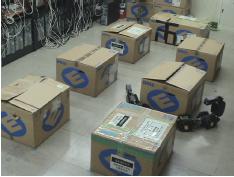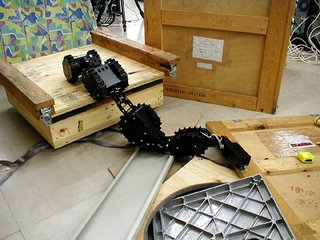Snake-Like Robot - KOHGA
U0205332 Yang Shaohua
The following news comes from Daily Times (Monday, September 22, 2003), which introduce a snake-like rescue robot - KOHGA, invented by japanese reseachers. It could be used for many complex environment where human being can not reach easily or safely. Actually, a similar snake-like robot was also used in looking for the survival after the attack on New York's World Trade Center on Sept. 11th,2001.
One technical paper named "Evaluation of Snake-like Rescue Robot - KOHGA for Usability of Remote Control" is also uploaded on IVLE for further reading.
 Research in many Japanese universities is geared towards earthquake rescue and recovery due to the archipelago’s vulnerability to large tremors. The most recent, a huge earthquake that struck the western city of Kobe in January 1995, killed more than 6,000 people. Most died of exposure of asphyxiation after being trapped under rubble.
Research in many Japanese universities is geared towards earthquake rescue and recovery due to the archipelago’s vulnerability to large tremors. The most recent, a huge earthquake that struck the western city of Kobe in January 1995, killed more than 6,000 people. Most died of exposure of asphyxiation after being trapped under rubble.
One technical paper named "Evaluation of Snake-like Rescue Robot - KOHGA for Usability of Remote Control" is also uploaded on IVLE for further reading.
TOKYO: Researchers in quake-prone Japan have developed snake-like robots capable of literally worming their way through the rubble of earthquake-destroyed houses to find trapped survivors.
A prototype dubbed Kohga — named after one of the two legendary schools of ninja spycraft — has been developed by Fumitoshi Matsuno, a professor at Tokyo’s University of Electro-Communications’ Mechanical Engineering and Intelligent Systems.
Snake-like robots “can go into narrow places and their long and thin bodies can disperse the weight to prevent a secondary collapse of wrecked structures,” Matsuno said. The two-metre (6.6-foot) long robot is propelled by ridged belts like tank tracks. “The survival rate of trapped people is said to plunge after 72 hours, and rescue operations are a race against time,” Matsuno said. Kohga can be dismantled into about 10 parts for transport to disaster sites. “It is very important that rescue robots can be transported easily,” Matsuno said.
 Research in many Japanese universities is geared towards earthquake rescue and recovery due to the archipelago’s vulnerability to large tremors. The most recent, a huge earthquake that struck the western city of Kobe in January 1995, killed more than 6,000 people. Most died of exposure of asphyxiation after being trapped under rubble.
Research in many Japanese universities is geared towards earthquake rescue and recovery due to the archipelago’s vulnerability to large tremors. The most recent, a huge earthquake that struck the western city of Kobe in January 1995, killed more than 6,000 people. Most died of exposure of asphyxiation after being trapped under rubble. The radio-controlled Kohga, which is equipped with a built-in camera for remote monitoring, is battery powered or can be fitted with a power cable in situations where the radio signals could interfere with other rescue services.
Another snake robot, Moira, was developed by Kyoto University systems science associate professor Koichi Osuka. Its name is an acronym of “mobile inspection robot for rescue activity” but is also that of the Greek goddess of fate.
Moira’s body has two sets of caterpillar tracks on either side of its sections that push it thorugh rubble. “The Moira can move more powerfully if it pushes against rubble from the side,” Osuka said.
The robot is 1.4-metres long and weighs 18 kilogrammes (39.6 pounds). “Snake-shaped robots are especially suited to rescue operations in Japan or other Asian countries since wooden structures leave little space to go through when they collapse, unlike buildings made of stone or mud,” he said.
